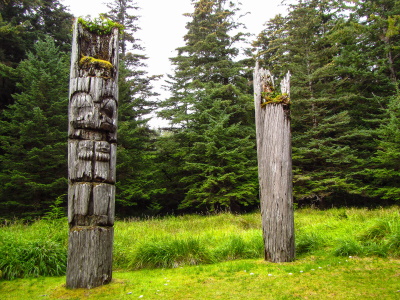SGang Gwaay

SG̱ang Gwaay holds the remains of traditional cedar longhouses and carved poles of the Haida.
This former village on the eastern side of Anthony Island was inhabited until the late 19th century. It still has a place in the traditions of the Haida culture. It has the largest collection of Haida totem poles in their original locations, many celebrated as great works of art.
Community Perspective: this is a remote place at the far southern end of the Gwaii Haanas National Park Reserve. Jay recently delivered a full report on the experience of visiting (“the poles are still standing … but the fine details on the poles continue to fade"), including the practicalities of getting there.


Map of SGang Gwaay
Load mapCommunity Reviews
Jay T

The poles are still standing. It has been over fifteen years since the last review of SG̱ang Gwaay, but the remarkably carved memorial and mortuary poles that led to this site being inscribed on the World Heritage Site are still in place. Weathering and decay are taking their natural toll on the village, as the fine details on the poles continue to fade. As far as the Haida people who populate the islands of Haida Gwaii are concerned, however, this is an expected part of life and should not be prevented.
Haida art became particularly well known worldwide through the craftsmanship of Haida artist and conservationist Bill Reid, whose lineage traces to the village of T'aanuu in Haida Gwaii. Bill salvaged many poles from villages throughout the islands and introduced Haida art to a global audience. His work has been featured on the Canadian 20 dollar bill, and one of his most famous sculptures, The Spirit of Haida Gwaii, sits in front of the Canadian Embassy in Washington, DC. When the World Heritage Site committee inscribed SG̱ang Gwaay on the World Heritage Site list in 1981, the choice of this village to represent Haida culture was in no small part due to the intricate carvings on the poles that so well represented Haida heritage and craftsmanship.
So what can be seen at SG̱ang Gwaay as of late summer 2022? Several mortuary and memorial poles still line the beach in front of the village. Mortuary poles were sets of poles erected to hold up a box with the remains of important persons from the village, while memorial poles were carved to honor specific people or important events. Carvings such as thunderbirds, bears, and whales can still be fairly easily identified on the poles. Interestingly, other villages I visited in Gwaii Haanas National Park Reserve and Haida Heritage Site did not have poles with such elaborate carvings, suggesting that SG̱ang Gwaay at one time had some skilled craftsmen in the village.
Also of note at SG̱ang Gwaay is a fairly large house pit, which is all that remains of one of the houses in the village. We were told by the Haida Watchmen at a separate village that the bases of Haida houses were dug in a day and the floors were laid down with cedar planks before nightfall so as to keep spirits from moving in and causing restless nights. The house would be constructed above the pit, with a large frontal pole anchoring the front wall, and additional poles holding up the beams of the one story house. The frontal pole would be carved with the family crests, and a doorway was cut into the bottom of the pole for guests to enter. In the center of the pit inside the house was a fire that would be used for cooking and warmth. The depth of the pit varied according to the importance of the family, so that there were some houses with stepped levels. At the large house pit that we observed at SG̱ang Gwaay, the beams of the house and the pit were still visible, though the wood continued to decay. The frontal pole was no longer present; many frontal poles from houses across Haida Gwaii were sent away to museums.
SG̱ang Gwaay was set in a small harbor with an island protecting the beach. The inhabitants of the village would have been able to fish and forage easily from their village. Unfortunately, although the Haida initially profited from contact and trade with the outside world, with contact came troubles, and in the 1860s a smallpox epidemic swept through Haida Gwaii, reducing the population of SG̱ang Gwaay so drastically that the remaining villagers moved to the community of Skidegate further north by 1878. The village was left in a state of decay that has continued to the present.
So what happens when all the wood has decayed in SG̱ang Gwaay, and all that is left are the house pits? I daresay it will be similar to other World Heritage Sites I've seen such as Birka or Cahokia Mounds, where some imagination will be necessary to comprehend what the village would have looked like. Thankfully, the Haida people have established a Watchman program, which places Haida volunteers at select villages in the islands to act as interpreters for the controlled visits to the sites. (Unfortunately the Watchman at SG̱ang Gwaay was out sick when I visited, but the guide on my tour was also well trained to interpret the site) Some people I talked with speculated about the value of a recreated Haida village in Gwaii Haanas, similar to the reconstructions of the longhouses at L'anse Aux Meadows, in order to give a better perspective of what the sites looked like. That could help, but that would have to be a decision for the Haida people to make, and as long as they maintain Watchmen, it may not be necessary. There is also a proposal for an extension of SG̱ang Gwaay to include the entire Gwaii Haanas National Park Reserve and Haida Heritage Site (with other unique villages), but that is a topic for a separate review. SG̱ang Gwaay in its present form will not last forever (nor should it), so I recommend visiting within the next decade or two before even more of the carvings fade away.
Logistics: SG̱ang Gwaay is at the far southern end of the Gwaii Haanas National Park Reserve and Haida Heritage Site, and can only be reached via established tour operators operating small tours in Haida Gwaii. Unfortunately, due to Covid, some tour operators are no longer working. I chose a 4-day tour with Moresby Explorers, an excellent company offering a Zodiac boat tour to different sites within Gwaii Haanas. For those with kayak experience, there are also guided kayak tours. The two main ways to get to Haida Gwaii are by plane to Sandspit on Moresby Island or to Masset on Graham Island, or by ferry from Prince Rupert to Skidegate on Graham Island. There is a regular daily ferry between Skidegate on Graham Island and Allisford Bay (near Sandspit) on Moresby Island. I didn't make it to Graham Island, but the Haida Heritage Center in Skidegate was highly recommended by fellow members of my tour group.
Read more from Jay T here.
Trevor
I recently went on a kayaking trip to SGaang Gwaii and found it to be an fascinating place. The old totem poles and long house were great to see as they will not be there much longer.The Hiada people believe they came from the earth and that they should return to the earth. They are located on the southern part of the Queen Charlotte Islands. I found a travel company on the internet located in the Charlottes. About the only way to get down to SGaang Qwaii is to use one of these companies as the last road is 100 miles to the north. We also stopped at Skedans an equally impressive site and should not be missed. I highly recommend going you will not be disappointed. Don't forget to ask about the hot springs.
Site Info
- Full Name
- SGang Gwaay
- Unesco ID
- 157
- Country
- Canada
- Inscribed
- 1981
- Type
- Cultural
- Criteria
-
3
- Categories
- Archaeological site - Pre-Columbian
- Link
- By ID
Site History
2006 Name change
From "SGaang Gwaii (Anthony Island)" to "SGang Gwaay"
2000 Name change
From "Anthony Island" to "SGaang Gwaii (Anthony Island)"
1981 Inscribed
Site Links
Unesco Website
Official Website
Related
In the News
Connections
The site has 16 connections
Architecture
Geography
Human Activity
Timeline
Trivia
Visiting conditions
WHS on Other Lists
World Heritage Process
Visitors
9 Community Members have visited.